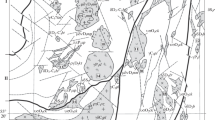Abstract
The temperatures at which melting begins of three New Zealand greywackes and two argillites were determined as a function of water pressure up to 3000 atmospheres. The purpose of these experiments was to provide data possibly relevant to the genesis of the North Island ignimbrites and for comparison with the experiments ofBowen andTuttle (1958) on the melting temperatures of granites and the ternary minimum system (NaAlSi3O8 — KAlSi3O8 — SiO2 — H2O).
Powdered samples of the rocks were heated in unsealed silver tubes in cold seal bombs, the water pressure being measured on a Bourdon gauge and applied during heating. Temperature control was ± 5°C. Twelve days was the longest heating period, most being for 24 hours, which was sufficient for apparent reaction. At the end of an experiment, the pressure was released, and the sample quickly cooled by removal from the bomb. The samples were crushed and examined by X-ray diffraction and the petrographic microscope.
The PT curve for the beginning of melting of the greywackes and argillites is very close toBowen andTuttle’s for granites and the ternary minimum to 1000 atmospheres water pressure. Above this pressure the greywackes melt at slightly higher temperatures than on the granite curve with the argillites a little higher still. These observations are similar to those reported for shales byWyllie andTuttle 1960, 1961, for greywackes byWinkler andvon Platen 1961, and pelitic sediments byWyart andSabatier, 1959.
The amount of anatectic melt increases rapidly above the temperature of initial melting and is inversely related to the quartz present in the greywackes. The partially melted products were often notably vesicular. Cordierite, mullite, hypersthene, scapolite and mica were identified in the X-ray diffractograms as coexisting with the melt.
These experiments are in agreement with published work in showing that the quartz and alkali feldspars of granites, shales and arkosic sediments can in the presence of water react and begin to melt at 20–25 kilometres depth in the earth assuming a geothermal gradient of 30°C/km. The melt is granitic or granodioritic in composition.
Similar content being viewed by others
Author information
Authors and Affiliations
Additional information
Paper read at the IAV International Symposium on Voleanology (New Zealand), scientific session of Nov. 25, 1965.
Rights and permissions
About this article
Cite this article
Rogers, J. Hydrothermal melting of some New Zealand greywackes and argillites. Bull Volcanol 29, 173–175 (1966). https://doi.org/10.1007/BF02597151
Issue Date:
DOI: https://doi.org/10.1007/BF02597151



